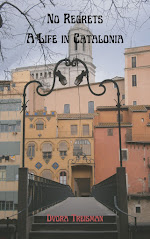


If
Spain interests you, three books come to mind that you may want to read. All three are non-fiction, one is a history and the other two are memoirs that gently take you back to an earlier age.

The history is
Barcelona by Robert Hughes. I read this before my first visit to
Barcelona and have reread it twice since. Although I can remember what I ate in
Seattle on a trip there with Uri in about 1972 (salmon grilled on alder wood – simple but unforgettable), I don’t tend to remember facts I read in history books. But it doesn’t matter because I get the gist of it and that’s good enough for me. In spite of my faulty memory, I have managed to remember many things from this interesting book.
Anyone wanting a background not only to the history of Barcelona but to the history of Catalunya is advised to read this book. Hughes knows his subject well. In fact, the book is used in a course on Catalan culture for English-speakers at the University of Barcelona in their summer program. In it, among other topics, you will find a discourse on the caganer, the little figure found in most nativity scenes at Christmas who is squatting and shitting. Apparently Catalan culture is full of scatology, however, for all the information Hughes presents, the origin of the caganer remains obscure.


The two memoirs are of a bygone era. The first,
Two Middle-Aged Ladies in Andalusia, by Penelope Chetwode was written in 1963 and tells the more recent tale of the two ladies, Mrs. Chetwode herself and
La Marquesa, the mare she rode through the countryside of
Andalusia in the early 1960s. Mrs. Chetwode was enamored of
Andalusia. It seems that everyone she met treated
her as the marquesa, instead of the horse. Although she wrote well, I found her attitude to be patronizing and some of her details to be doubtful, although I suppose it
is possible that at late as 1963 all the peasants in the South of Spain were still eating their meals, fork in hand, out of the common pot or paella pan. After all, they do still share wine flasks. She was quite taken with the custom, marveling that thus there were very few dishes to wash up.
Mrs. Chetwode was a devout Catholic and it is perhaps that, in addition to the adoration she commanded from the local peasants, that endeared Spain to her. She attended mass at every village, dined with every priest, and became a great fan of Franco, the Spanish dictator who preserved and promoted the Spanish Church. I wondered if she would have liked him quite as much if he had been the ruler of England.


The Two Ladies is well written and engaging, if not sometimes annoying, but it offers no competition to Laurie Lee’s
As I Walked Out One Summer Morning. Lee was a poet. His views are humane and his writing is lyrical, simple, and elegant. Published in 1969, As I Walked Out tells of how in 1934 Lee left his home in Stroud, Gloucestershire and walked to
London. He was 19 years old. After one year, he got on a boat and sailed to
Spain. Once landed, he saw
Vigo,
Segovia,
Madrid,
Toledo, Cordova,
Seville,
Granada, doing all his travels by foot. He didn’t make it here to
Barcelona because the Spanish Civil War began and he was repatriated. But he was infected with a lifelong love of
Spain and he did come back later to join the Republicans in the International Brigades. But that’s another book.













Dvora, do you know any good books on the Inquisition period?
ReplyDeleteHarley, no, I don't know of any books on the Inquisition, good or otherwise.
ReplyDeleteThe best books I know of about Spain are the Laurie Lee, the Robert Hughes about Barcelona/Catalunya, and The Basque History of the World by Mark Kurlansky, none of which have anything to do with your question! but all of them very good.